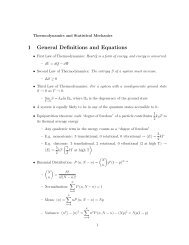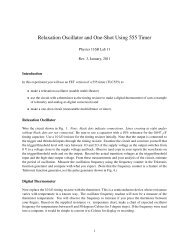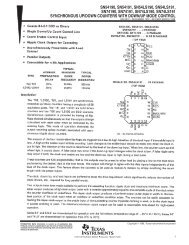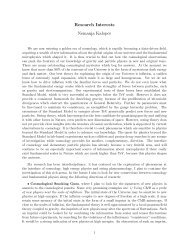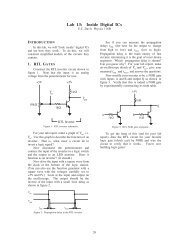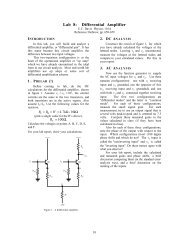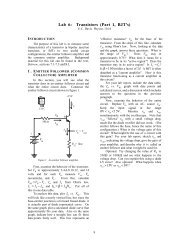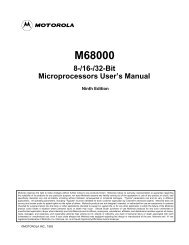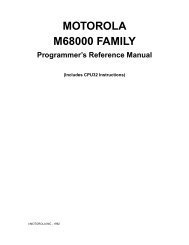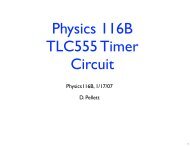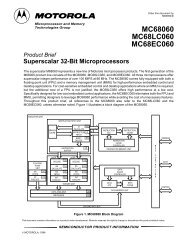Lab 2: Op Amp Circuits - UC Davis
Lab 2: Op Amp Circuits - UC Davis
Lab 2: Op Amp Circuits - UC Davis
Create successful ePaper yourself
Turn your PDF publications into a flip-book with our unique Google optimized e-Paper software.
Current Source<br />
~<br />
+15V<br />
I in<br />
Current-to-Voltage Converter<br />
R 2<br />
= 100k Ω<br />
_<br />
+<br />
V out<br />
Figure 5: Photodiode with current-to-voltage converter.<br />
Now replace the current source with a<br />
photodiode as shown in figure 5. Look at V out<br />
with the oscilloscope. For your lab report,<br />
measure the intensity of light (steady and<br />
oscillating) in the room.<br />
4. INTEGRATOR<br />
The name "operational amplifier" came from<br />
this amplifier's ability to perform mathematical<br />
operations. Two good examples of this are the<br />
integrator and differentiator which perform the<br />
operations of integration and differentiation,<br />
respectively. These are described in Bobrow in<br />
examples 3.7 and 3.4, respectively.<br />
10ΜΩ<br />
and describe what happens. Briefly discuss this<br />
in your report.<br />
5. DIFFERENTIATOR<br />
Construct the differentiator circuit in figure<br />
7. Sketch the input and output waveforms for a<br />
1kHz sine wave, triangle wave, and square wave<br />
input as for the integrator. For your report,<br />
include your sketches and show that the output<br />
waveform is indeed the derivative of the input<br />
waveform.<br />
v in<br />
1k Ω<br />
0.01 µ F<br />
100 pF<br />
100 kΩ<br />
Figure 7: The differentiator amplifier circuit.<br />
_<br />
+<br />
v out<br />
Note here that the 100 pF capacitor (a very<br />
small value) is not in the ideal amplifier. Why<br />
do you think it is here? (Think about the<br />
derivative of a square wave, for example. Could<br />
high voltages damage a chip or put a significant<br />
noise into the circuit?) Briefly discuss this in<br />
your report.<br />
v in<br />
100k Ω<br />
_<br />
0.01 µ F<br />
+<br />
v out<br />
Figure 6: The op amp integrator circuit.<br />
Construct the integrator shown in figure 6.<br />
Sketch the input and output waveforms for 1kHz<br />
sine wave, triangle wave, and square wave inputs.<br />
Try to guess what each waveform will look like<br />
ahead of time. For your report, include your<br />
sketches and show that the output waveform is<br />
indeed the integral of the input waveform.<br />
Note that the 10MΩ resistor (a very large<br />
value) is not in the ideal integrator circuit. What<br />
is it there for? (Think about what would happen<br />
if a small DC component was present in the<br />
input waveform. What would integrating this<br />
constant do after a short time?) Try removing it<br />
5 5



